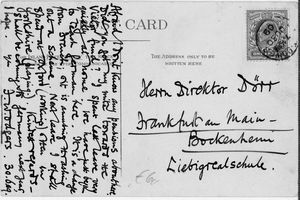Catalogue number 131033
Rope splicing drill, Osborne 1909, verso
This postcard was sent by F.W. Ogers, Assistant Master (French) at Osborne College (Navvy List, 1907) to Dr Dörr, Director of the Liebig Real Schule, Bockenham, Frankfurt, Germany. It illustrates the close links that existed between the Royal Navy and Germany. Ogers writes that the Head of Osborne College will be "delighted" to receive someone from the "Humboltschule" (sic). He also asks if Dörr had received his contribution to the Viëtor fund. This was a fund set up to promote a new approach to foreign language teaching emphasising oral work and phonetics as opposed to the classic method of simply doing translations.
Verso: Franked Cowes, 1909
13.7cm x 9cm Printed image
|
 |